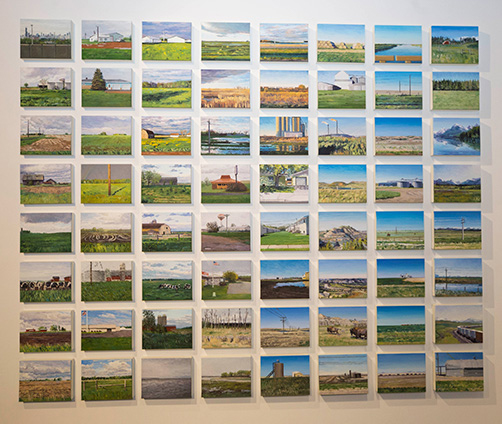Landscape Art and Virtual Travel: Highlights from the Collections of the HRM and Art Bridges
At a time when the pandemic has forced us to redefine tourism, Landscape Art and Virtual Travel: Highlights From the Collections of the HRM and Art Bridges celebrates artists’ striking ability to transport us to real and imaginary places.
American landscape paintings have always been intertwined with explorations of the great outdoors. In the mid-nineteenth century, many artists meditated on the sublimity of nature, whether gazing at the Hudson River’s Palisades or embarking on a far-ranging tour. Landscape painters brought distant places into the homes of their patrons and, popularized in books and prints, landscape art inspired a growing middle class to travel to these destinations. Artists continue to bring the world to us and send us out on our own adventures to this day.
As a city-based museum overlooking the magnificent scenery of the lower Hudson River, we use our unique location as a lens to look more closely at people and their environments. Our local community’s experience in light of recent travel restrictions reminds us that journeys of the mind can be freeing. Landscape Art and Virtual Travel features new loans from Art Bridges: Cynthia Daignault’s Light Atlas and David Hockney’s 15 Canvas Study of the Grand Canyon. The exhibition ushers in the third year of our partnership with Art Bridges, which facilitates the sharing of outstanding works of American art and supports partner institutions in expanding and deepening their connection with audiences. These important loans offer rich potential for dialogue with nineteenth- to twenty-first-century paintings, prints, and sculpture from the Museum’s collection.
The works in the exhibition shed light on the power of art to influence ideas and actions and the process by which these precious lands might be protected. The display includes the engraving of Youth from Thomas Cole’s 1842 allegorical Voyage of Life series, in which he used a river to represent life’s journey and convey a morally persuasive message. Focusing on an actual locale, Asher B. Durand painted an untitled view in the White Mountains of New Hampshire, an area visited by many Hudson River School painters in search of awe-inspiring scenery. Thomas Moran, whose paintings helped inspire Congress to create the first National Parks, is represented by an etching of the Cross in the Rockies. Works such as these, by male artists, prompted Cynthia Daiglnault’s personal and artistic journey to create her Light Atlas, which consists of 360 small paintings. Realizing that due to historical inequities in presentation, she could not name one nineteenth-century female artist explorer, she made a circle through the continental United States, stopping at regular intervals to document her experience, from roadside architecture to empty countryside. In the late 1990s, British artist David Hockney traveled to the American West to paint the Grand Canyon, leaving out himself and other visitors to let the viewer of his artwork connect with the vast unpopulated landform he depicted.
The exhibition also demonstrates some of the ways in which Native Americans, African Americans, and other marginalized people have successfully and potently staked their claim in the face of historic denial of ownership and connection to American soil. In Patuckquapaug and related images, contemporary photographer Jeremy Dennis, whose work is on loan to the Museum, documents scenic places on Long Island that are culturally important to him and the Shinnecock Indian Nation.
Fictional landscapes can convey very real, complex, thought-provoking messages: in Map of the Frenglish Kingdom of Novum Eboracum (New York) (We All Got To Have a Place We Call Home), Frohawk Two Feathers imagines an alternative colonial history of the Hudson Valley, with a multiracial society ruled by a Black pharaoh. The artist’s faux map of the Hudson reminds us that the underlying message of many Hudson River School landscapes, whether intentional or not, was a sense of White ownership. Incorporating materials found in nature as her canvas, Alison Moritsugu prompts us to explore the precarious relationship between humans and the environment. The idyllic scenes rendered on a fallen tree compel us not to fall for false assurances that the wilderness we take for granted will always exist without our advocacy.
Artists also included from the Museum’s collection are Marie Louise Brevoort, Jordan Matter, James McElhinney, Richard Mayhew, and Don Nice.
Landscape Art and Virtual Travel and its related programs address questions such as how we define landscape and how it defines us; the power of nature to soothe and refresh us; how our presence intentionally and unintentionally changes it. We pose these questions to all: Are we conditioned by art to see and experience the actual landscape in certain ways? How does the history of a terrain change the way we feel about exploring it for ourselves? Ultimately, we believe that landscape art encourages a thoughtful consideration and an expanded appreciation of our relationship with our environment, and with each other, both of which can offer wholesome respite in these difficult times.
Support provided by Art Bridges.
Image: Cynthia Daignault (American, b. 1978). Light Atlas, 2016. Oil on linen, 360 canvases. On loan from Art Bridges (AB.2019.2).
Event Location and Ticket Information
Hudson River Museum
511 Warburton Avenue
Yonkers, NY 10701
Handicap Accessible? Yes
Date: Sunday, March 14, 2021
Times: 12:00 pm - 5:00 pm
Ticket pricing:
Free event
Get tickets now
$8 - Adult
$4 - Youth
$5 - Senior
$5 - Veteran
$5 - Student w/ID
$0 - FREE (children 3 & under))
Presenter: Hudson RIver Museum
Presenter Phone: 914-963-4550
Presenter Website: hrm.org

